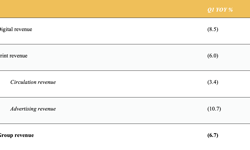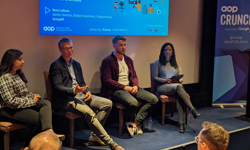Unveiling forthcoming plans, as well as delivering an overview of the Condé Nast Digital division developments to date, Nicholas Coleridge (pictured) comments: “The principal pillars to our strategy are integration, investment, innovation and insider intelligence, with editorial excellence as the foundation stone of our planning. We were at the vanguard of publishing online and have more than 15 years experience in the digital space – it’s an area we have consistently invested in, in terms of technology and talent. Producing engaging content is what Condé Nast’s business is about. It is great content that connects all facets of our business and is the bedrock of our strategy past and present.”
Nowhere will this be better represented than in the first two iPad apps from Condé Nast – the Vogue and Wired December issues will be available on iTunes early November. Albert Read, General Manager for Condé Nast, who is playing a key role across digital initiatives, remarks: “To date, digital media consumption has been biased towards a ‘lean forward’, information-gathering experience. The arrival of the iPad marks a significant shift for digital towards the ‘lean back’ environment - at home, on the sofa, and on the move. We have arrived at a point where magazine publishers have before them what they have long dreamt of – an opportunity to transfer the magazine qualities of deep immersion, high resolution images, long form journalism and storytelling to a digital format. Meanwhile, the distribution challenges evaporate and we can reach out to new audiences all over the world.”
The Wired iPad app is being developed by an expanded editorial team, overseen by Wired Editor David Rowan and Art Director Andrew Diprose, working closely with Adobe using the Digital Management Magazine Solution technology. And Vogue’s Editor Alexandra Shulman, and Creative Director Robin Derrick, are working with Spring Studios and Six Creative to re-imagine the fashion bible for the digital era, to deliver a compelling media-rich experience, setting the industry benchmark.
Commercially, any advertiser appearing in the print edition of these issues will automatically appear on the iPad app. For those clients keen to expand their brand experience, there will be a chance to include a standard link to their website or to any other digital properties. And for a limited number, the potential of the iPad as an advertising vehicle is significant, offering augmented interactive advertising formats to ensure a fully immersive experience (whether video, slideshows, photo explorer, 360 imaging or product tours).
The company says that its research indicates that 50% of its magazine readers have some firsthand experience of the iPad – and they like it. 18% of Wired readers already have their own iPad, 5% use them at work and 79% of Wired readers have had some firsthand experience of the device. And 71% of iPad owners are reading magazine on newspaper content on their iPads at least once a week, with a third reading via their iPad every day.
Turning attention from the iPad to iPhone, Jamie Jouning, Publisher for Condé Nast Digital, expands on future plans for iPhone apps, capitalising on the increasing levels of mobile digital access, revealing, “We’re developing apps for both GQ and Brides for release at the end of the year. The commercial model for both is built on a simple headline sponsorship basis with a single advertiser taking complete ownership of the app, and we will integrate the advertiser’s message within the editorial fabric providing a seamless, engaging and immersive brand experience.”
Condé Nast Britain’s entry to the iPhone apps market was earlier this year, in July, with the Condé Nast Traveller City Guides, and these four apps show how the creative application and marriage of content with technology can work to great effect. The City Guides for Rome, New York, Barcelona and Paris, are updated free of charge quarterly and include insider guides, restaurant reviews, a function to call and make a reservation, GPS to take you there, as well as audio tours, and augmented reality. These paid-for apps are a joint collaboration between the magazine, under the editor Sarah Miller, and our digital team.
Across the industry more people are looking at monthly magazine websites than ever before – particularly glossy magazine sites, says the company. While online usage has increased by 5% overall in the past year, usage of glossy sites is up by more than ten times that figure - +51% according to net view.
Set against that backdrop, the Condé Nast websites remain the core of Condé Nast’s digital business, in spite of the opportunities generated by the new era of digital mobility. Jamie Jouning remarks: “The sites play a complementary role and one that provides advertisers with yet another way to target our influential audience. While our magazines – in print and in soon to be released iPad format - represent a narrative to immerse yourself in, the websites represent a fast, immediate take on what’s happening right at that moment.”
Condé Nast’s websites claim to generate more than 350 million gross impressions a year, and collectively have more than 2 million unique users. This figure is growing dynamically and is up 101% over the past three years, with page impressions up 46%. Meanwhile integration is reaping rewards – from a commercial perspective, cross media revenue in 2010 has increased by over 60% against 2009 and now accounts for almost 20% of Condé Nast Digital’s total display revenue.
Condé Nast concludes: “The scale of the audience we communicate with through our media products is immense (globally Condé Nast has 153 million readers and 61 million unique users), and so too is our database. This is an area we have also been investing in, across print and digital. We’ve always invested in consumer research, but now we’re investing more in building and maintaining a database that’s rich in consumer behaviour information that we know will be really useful to the advertiser. Condé Nast is fast developing into a multi-platform quality content provider, offering multiple touchpoints where consumers and advertisers can access superlative content and unique audiences. The ability to offer this holistic 360 degree experience, while maintaining our high creative standard across all platforms, is a fundamental part of our plans.”










